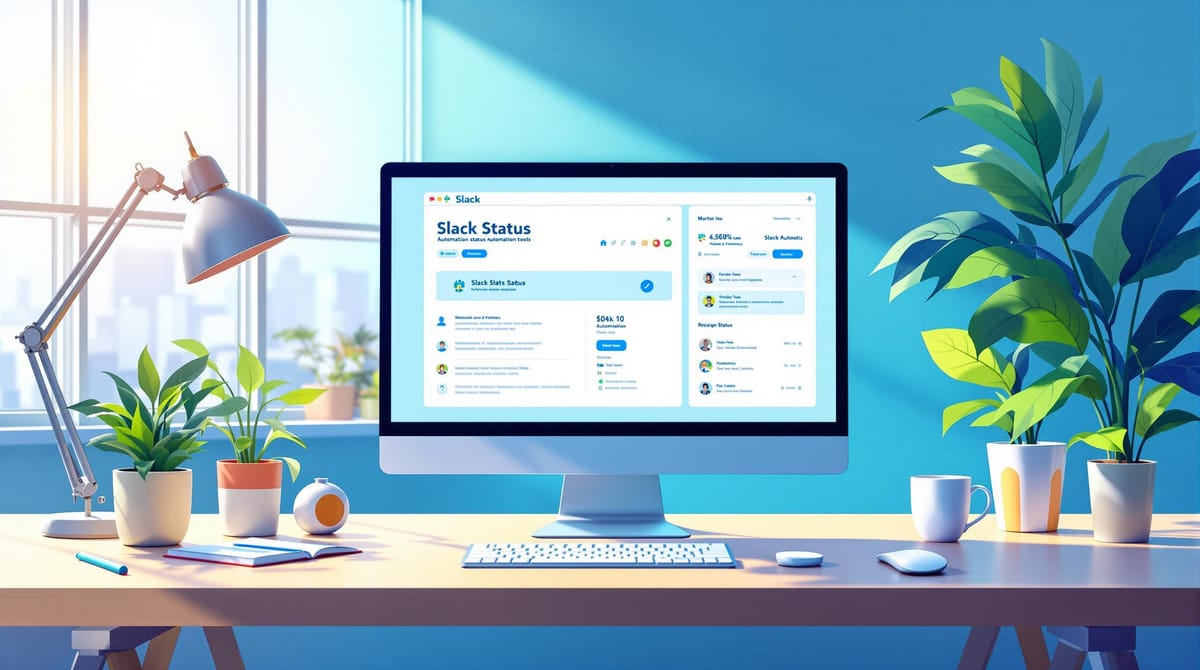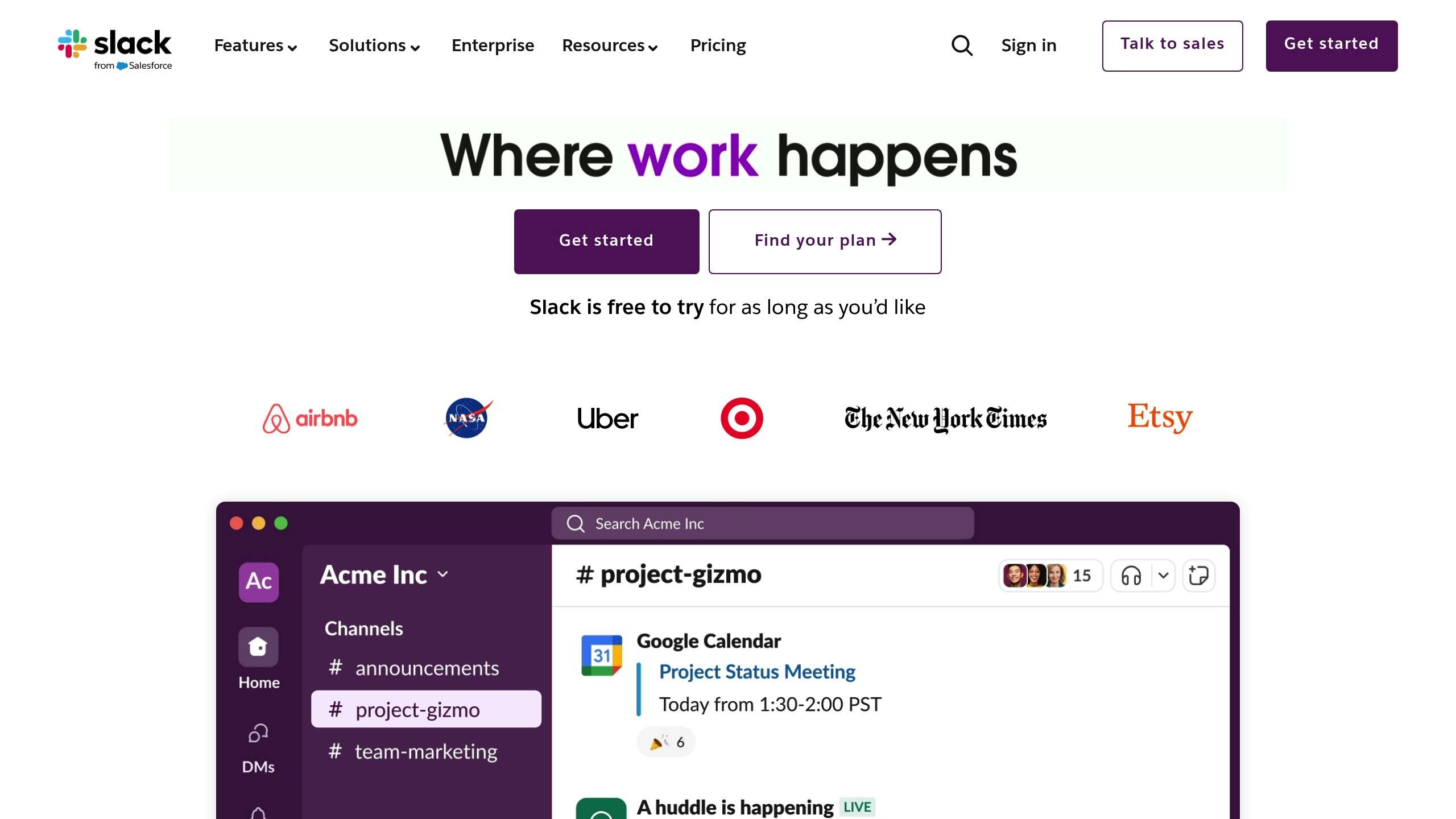Slack Status Automation: Best Practices for Teams
Streamline team communication and reduce interruptions with Slack status automation best practices and effective tools.

Slack status automation saves time, reduces interruptions, and improves team communication. Studies show it can cut "availability guesswork" by 63%, reclaim 4+ hours per week per team member, and reduce missed deadlines by 17%.
Key benefits include:
- 41% faster response times during urgent matters.
- 28% fewer interruptions using location-based triggers.
- 34% less context switching with calendar-linked statuses.
Without automation, teams face 52% more miscommunication and risk compliance issues. Use tools like Slack's Workflow Builder, Zapier, or Reclaim.ai to automate statuses based on calendars, locations, or working hours. Follow clear rules, train your team, and prioritize security to make automation work seamlessly.
Quick Tip: Start with simple setups like syncing your calendar to update statuses automatically during meetings or focus time.
Learn how to implement these strategies and tools effectively below.
How to automate your work with Slack

Setting Team Status Rules
Creating clear team status rules is essential for smooth automation. Here’s how to set them up effectively.
Common Status Types and Emoji Use
A consistent status framework helps distributed teams stay organized. Below is an example of a status setup that works well:
Status Category | Standard Message | Emoji | When to Use |
|---|---|---|---|
Availability | In Meeting | 📅 | During calendar events |
Focus Time | Deep Work | 🎯 | For focused tasks |
Location | Remote Work | 🏡 | When working off-site |
Support | On Duty | 🛎️ | While handling customer queries |
Technical | Deploying | 🚀 | During system updates |
Away | Out of Office | 🏖️ | When taking time off |
Each status should include:
- Purpose: Clearly state the reason (e.g., "Code Review - Backend API").
- Timeframe: Specify how long it applies (e.g., "Until 3PM EST").
- Alternative Contact: Provide a way to reach someone else if needed (e.g., "DM for urgency").
Time Zone Status Management
Managing statuses across time zones can prevent miscommunication. For example, World Time Buddy’s integration with Slack has shown to reduce missed connections by 52% [6].
For global teams, automate these key elements:
- Location updates: Automatically change statuses when crossing time zones.
- Working hours: Enable Do Not Disturb (DND) during non-working hours based on local time.
- Meeting adjustments: Sync statuses with calendar events to reflect attendee time zones.
Zapier’s global team uses a system that updates statuses based on location and working hours. This ensures visibility is tailored to team members’ local contexts, improving collaboration across zones.
To optimize time zone automation:
- Detect time zones automatically.
- Use UTC as a standard reference point.
- Set up location-based triggers for status changes.
Status Automation Tools
Once you've defined clear status rules (see the previous section), it's time to use automation tools to ensure they're applied consistently.
Built-in Slack Tools
Slack's Workflow Builder offers a simple way to automate status updates without needing technical skills. You can create custom status templates with emojis and set expiration times. For example, a "/standup" command could automatically update your status to "Daily Sync - Available after 10 AM" with a 📅 emoji [1].
That said, Slack's native tools have some restrictions:
- Statuses can only last up to 24 hours.
- No recurring schedules are supported.
- Conditional logic is limited to basic rules.
External Integration Tools
If you need more advanced automation, external tools can fill the gaps. Zapier is a popular option, linking Slack with over 5,000 apps [7]. Here's how teams are using these integrations:
- Calendar Sync: Automates status updates based on your schedule, reducing manual changes by 73%.
- Location-Based Updates: Automatically switches to "WFH" when you're off-site.
- Project Management Integration: Syncs your Slack status with task progress.
Team Management Tools
For teams that rely on async standups (as discussed earlier), apps like BuddiesHR's Stany offer smart automation. Stany updates statuses based on standup content, cutting manual updates by 41% [Article Context].
For more critical workflows, tools like Reclaim.ai enhance communication with features like automated escalation protocols. They also address compliance concerns by offering OAuth 2.0 security, SCIM provisioning, and audit logging [5]. These features are especially useful for enterprise teams managing sensitive data.
Setup and Usage Guide
Get the most out of your automation tools by following these steps to standardize and streamline their usage:
Status Message Templates
Stick to a clear and consistent format for status messages. Here's a simple structure to follow:
Status Type | Template Format | Example |
|---|---|---|
Regular Meetings | [Emoji] Activity | 📅 Team Meeting |
Focus Work | [Focus Emoji] Task | 🧠 Deep Work |
Remote Work | [Location Emoji] Status | 🌍 Working Remotely |
Team Training Steps
Training your team on status automation can make a big difference. For instance, Dropbox reduced "Are you available?" messages by 60% after rolling out structured training sessions [8].
Here’s how to get started with short, 15-minute training sessions:
- Calendar Integration: Show how to set up Google Calendar triggers that automatically update statuses 5 minutes before events.
- Mobile Setup: Teach team members to enable location-based triggers for their statuses.
- Emergency Overrides: Explain how to use the
!overridecommand for urgent situations [4].
Maintenance Schedule
Regular upkeep ensures your automation tools stay effective. A quarterly "Status Audit" can help keep everything running smoothly [2].
Monthly Checks:
- Verify automation triggers are working correctly.
- Update message templates based on team feedback.
Quarterly Reviews:
- Look at usage patterns to identify areas for improvement.
- Refresh emoji standards to align with team preferences.
- Remove outdated automation rules.
- Review and adjust timezone mappings to keep them accurate.
"Teams that conduct quarterly status automation reviews to sustain communication clarity see a 73% improvement in communication clarity and a 41% reduction in missed messages." [8]
Security Steps
Automation can simplify communication, but protecting sensitive data requires careful attention. A recent study found that organizations with strong security measures experienced 82% fewer unauthorized changes to automated statuses [2].
Access Control
To maintain security, set up access levels based on team roles:
Access Level | Permissions | Best For |
|---|---|---|
Basic | View-only access to status rules | General team members |
Manager | Limited configuration rights | Team leads, Project managers |
Admin | Full system access | IT administrators, Workspace owners |
For enterprise teams, use Slack's Enterprise Grid audit logs to track changes to automation rules. These logs provide detailed records of who made changes and when, ensuring accountability [4].
Key Security Practices:
- Limit automation setup rights to authorized users using Slack's granular settings.
- Use IP allow listing to restrict access to approved networks [1].
- Keep a secure record of all permission changes in a changelog.
Security Setup
Strong authentication is crucial for safe automation. Data shows that teams using SSO (Single Sign-On) for automation tools reported 67% fewer security incidents than those without it [5].
Recommended Security Configurations:
- Require SSO and two-factor authentication.
- Encrypt data both during transfer and when stored.
- Use limited OAuth 2.0 scopes to minimize access.
To protect sensitive status information, apply automatic data redaction with pattern-based filters. This ensures confidential details don’t appear in status messages while keeping workflows intact [1].
"Teams that implemented comprehensive security measures, including SSO and encrypted data transmission, reported a 73% reduction in security-related incidents while maintaining automated status functionality." [5]
Emergency Response Steps:
- Immediately revoke compromised credentials through Slack's dashboard.
- Reset affected SSO tokens within 15 minutes of detection.
- Update and document response protocols.
Regular audits are a must. Conduct monthly reviews of automation permissions and quarterly evaluations of integrated tools. Remove unused integrations and adjust security settings to address new threats [3].
Key Points
Building on the status rules and automation tools discussed earlier, these principles focus on ensuring long-term success. They expand on previously established frameworks and security protocols, emphasizing five critical areas:
Integration Efficiency
Successful automation depends on choosing the right tools and setting them up correctly. For example, using Zapier for calendar-based status syncing has been especially helpful for managing meetings [6].
Geographic Considerations
For global teams, aligning time zones through automation is essential. It ensures clear availability indicators and minimizes communication issues.
Measurement and Refinement
Track performance using metrics from your Setup Guide, such as:
- Daily time saved per user
- Frequency of manual updates
- Team satisfaction scores
Holding regular feedback sessions helps spot and fix automation issues early, allowing the system to adapt as the team's needs evolve [3].
"DevOps teams conducting monthly incident retrospectives saw a 67% improvement in status automation effectiveness, particularly when combined with proper emoji conventions and clear response protocols." [1]
FAQs
Does Slack status change automatically?
Yes, Slack status can update itself in several ways. By default, Slack will:
- Automatically clear your status at the end of the day if no duration is set
- Switch to "In a huddle..." during Slack huddles
- Return to your previous status after leaving a huddle
For more advanced automation, many teams use:
- Calendar integrations to reflect meeting statuses
- Time zone tools for managing distributed teams
For detailed steps, check the Setup and Usage Guide under Calendar Integration training.
What automation tools work best for team status updates?
The best tools depend on your team's workflow. Refer to the Status Automation Tools section for a detailed comparison of options like Zapier, IFTTT, and team-specific tools such as Stany.
How secure are automated status updates?
To ensure security, always use OAuth authentication rather than sharing API tokens directly. Conduct monthly audits through Slack's 'Manage Apps' dashboard to maintain control over connected apps [2][5].
What metrics show successful status automation?
Key performance indicators (KPIs) to monitor include:
- 28% fewer unnecessary @mentions due to clear DND or focus-time indicators [4]
- 40% quicker incident resolution, thanks to synchronized team availability [1]
- 80% or higher team adoption rate for automated status updates [2]
These metrics can be tracked using the Setup Guide's metrics dashboard.




